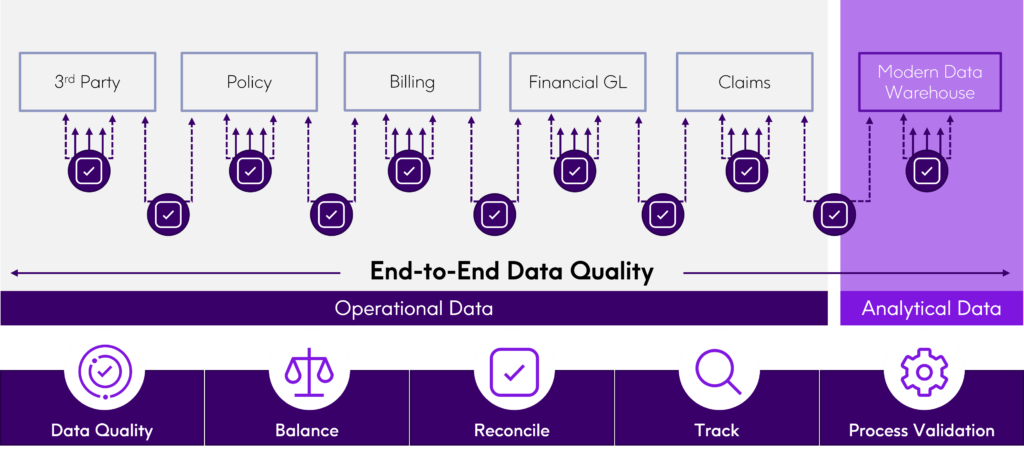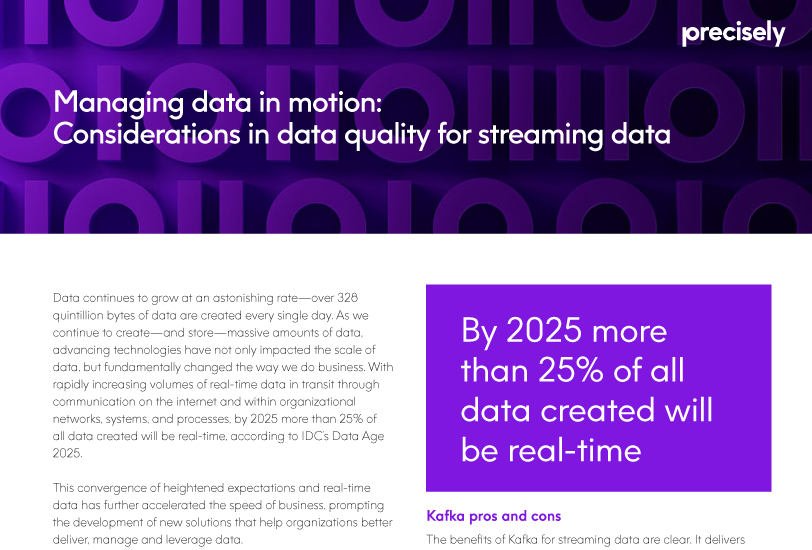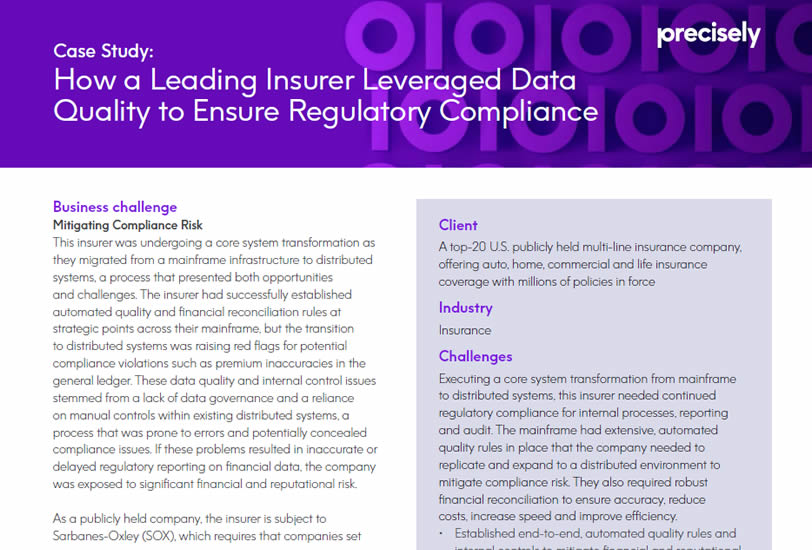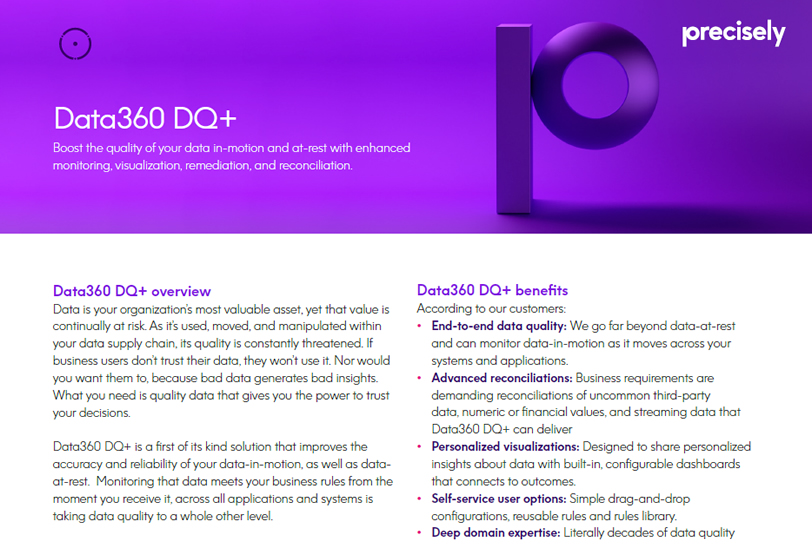
DATA QUALITY
Data reconciliation solutions
Increase accuracy, improve operational efficiency, and mitigate risk with automated data reconciliation.
Improve data integrity while maximizing efficiency
Data reconciliation is the process of comparing two or more datasets to reveal discrepancies, so you can be sure your data is accurate and complete across sources. With the right automated data reconciliation solutions across your business, you begin to experience big benefits – faster.
Improve operational efficiency
What areas of your organization currently reconcile data using spreadsheets? It’s an old-school way of operating, and it takes more time than it needs to. Automating enterprise reconciliation capabilities save your team valuable time, enabling them to:
- avoid rework
- improve cycle times
- simplify processes
Ensure regulatory compliance
Having a consistent, repeatable technique to perform data reconciliation activities across your organization helps to:
- ensure compliance with government regulations
- eliminate reporting errors
- streamline audits
- reduce the possibility of fines
Reduce potential risks
Ensuring the accuracy of your information using data reconciliation capabilities reduces potential risks to your organization. Automated data reconciliation capabilities help you:
- get early warnings for potential problems – so you can avoid catastrophic errors and damage
- protect your brand reputation and maximize customer engagement
- Ensure adherence to internal policies to minimize risk
Improved Operational Efficiencies Through End to End Financial Reconciliation
See how a top multi-line insurance company improved operational efficiencies and reduced regulatory risk with end-to-end financial reconciliation.


Reconcile data as it moves between your internal systems and processes
The ecosystem of large organizations is complex. Data is constantly moving between a variety of systems to enable operational and analytic processes. Data needs to be validated when it enters the organization and ongoing data quality checks are critical for both data in motion and at rest (stored in a specific location).
You need to ensure that data isn’t lost or transformed incorrectly as it moves throughout your organization. Some organizations refer to this as adding controls to the processes. This includes performing reconciliation on streaming data using various technologies, like Kafka.
Think of the impact of a $300,000 payment that’s incorrectly transformed to become a $3,000,000 payment. Small changes like this can have catastrophic impacts. Errors like these need to be caught before they affect downstream processes.
Precisely customer success story
Learn about the $10M mistake that almost went undetected by a large insurer – and how automated data quality rules saved the day.
Reconcile data from vendors and partners before it impacts your business
Imagine getting your organization’s internal data reconciled, then having a partner send data that creates errors or duplicate records.
Frustrating, right? Unfortunately, this happens at many organizations. The good news is that it’s avoidable with an automated enterprise reconciliation solution that compares incoming data with data already in your systems. This prevents the introduction of new data problems into your current environment.
Once you achieve high-quality data internally and you have a consistent process in place to validate incoming data, you can implement SLAs on data sent to you to ensure its quality meets your standards.
Precisely customer success story
See how a multi-billion dollar media company improved its internal processes by implementing reconciliations with incoming data from its vendors.


Ensure high quality data prior to reconciliation
Before data reconciliation, you need to ensure that standard data quality checks have been performed on the data being used. Examples of these data quality validations include:
- completeness: checks for nulls and that all required values are populated
- conformance: ensuring the data aligns with valid data types and patterns, and confirming that it falls within the expected valid value list or range
- consistency: cross-field value checks and situations with multi-field dependency requirements
- timeliness: ensuring the data is available when expected
This is just a sample of the data quality checks that may need to be applied to your data prior to data reconciliation. If you don’t perform these basic data validations first, then the reconciliation results may be unreliable.
Learn more about our data quality solutions
Gain consistency with enterprise data reconciliation solutions
How many of your data reconciliation processes are performed using a spreadsheet and then sending an email with exceptions? As you’ve probably noticed, this method is inconsistent, error-prone, and difficult for auditors to monitor.
That’s what makes an enterprise data reconciliation solution critical. It provides an array of benefits including:
- centralized exception management – this enables everyone to know where to go to resolve issues, and provides operational efficiencies including automated routing and required manager approvals designed to match your process
- audit logging – everyone can see who has touched an exception and see any notes and attachments
- visibility – configurable dashboards provide insight into the types of issues that are creating exceptions and who is working them
- automation – provides a feed back into appliable source systems to correct data issues found through the resolution process
Protect your organization with a unified data reconciliation process that’s automated, auditable, and reduces risk of compliance violations.

Industry-specific use cases to meet your needs
You may be wondering how data reconciliation helps solve your specific challenges. Here are a few examples by industry:
Financial services reconciliation
- Verify and track all financial transactions
- Streamline compliance efforts with regulations such as Know Your Customer
- Eliminate errors in accounts payable, ATMs, general ledger, etc.
- Lower audit costs
Insurance reconciliation
- Validate claims, financial reporting, and payments
- Track claim information during processing and detect dropped, duplicate, and incomplete claims
- Assure accurate billing, commissions, 1099s, and more
- Streamline regulatory compliance such as SOX, NAIC-MAR, etc.
Telecommunications and utilities reconciliation
- Enable effective revenue assurance with data reconciliation to:
- eliminate billing errors
- assure service delivery
- meet SLAs
- validate surcharges and taxes
- reduce write-offs and refunds
- Ensure accurate cash disbursements and other payments
- Automate controls for compliance with SOX and other regulations

Resources

Data reconciliation in action
Whatever your industry may be, all have something in common: data reconciliation helps solve challenges across the organization.
What are the biggest issues you need to tackle today? How can data reconciliation help? Now that you’ve found some inspiration through the use cases and success stories highlighted here, we want to hear from you.
Reach out to us for more information and to start experiencing the data reconciliation benefits for yourself today.
Interested in automatically observing data in motion using machine learning?
Check out our data observability solutions.




